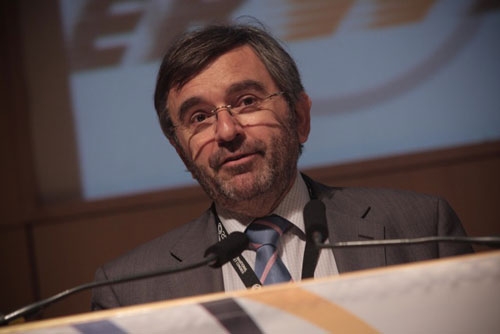THE commitments agreed by the 11 members of the European Railway Wheel Association (ERWA) cover three areas. Quality commitments cover a range of topics such as innovations to improve product life cycle, full traceability of materials, continuous investment in technology, Iris certification as standard, and improving steel grades as well as standards and regulations. ERWA's commitments to customers are designed to meet their requirements, provide day-to-day support to end users, and design products which meet defined infrastructure and operating conditions. Social responsibility commitments cover safety, helping to improve rail's competitiveness, and transparency.
I started by asking ERWA's outgoing chairman, Mr Jean-Pierre Auger, why the association felt the need to draw up these commitments. "If we consider the wheelset as a key safety component, we felt we needed to enhance some of the principles under which the European wheelset industry operates today.
We also had the feeling that some of our non-European competitors don't have the same commitments as us, for example regarding the traceability of materials. We also wanted to adopt a more general approach to the railway industry rather than just our customers, the rolling stock producers and operators.
"There were not really any areas where we had diverging views," Auger continued. "We all have a common history as our members have been active for decades."
ERWA members all produce forged wheels because Auger says European railways do not believe cast wheels are adequate. So production methods and therefore the quality of the end product are similar, and all the main production plants are Iris certified. Auger says traceability is in place both for original products and wheelset maintenance.
He says ERWA members invest between 2% and 4% of turnover in research and development. Several companies have invested in testing facilities to increasingly take on the work previously done by the railways or other organisations which could no longer keep up with mounting regulatory demands. For example, Lucchini has a full-scale wheelset testing centre.
Euraxles programme
"All our members are involved in the €5m Euraxles programme, which started in mid-2010 and will be completed in mid-2013, to redefine axle design criteria and axle protection," Auger explains. "This will provide a strong input into changing the standards for axle design and maintenance. After the serious accident in Italy and the problems encountered in Germany, we felt there was room for improvement, even though wheelsets have an outstanding safety record."
Auger says considerable progress has been made in reducing wheel life-cycle cost. Improvements in steel quality mean less reprofiling, less maintenance, and a longer life. "Trailer bogie wheels on French TGVs used to have a life of 800,000 to 1 million km, but during the last 20 years this has been extended to 2 million km through a steady improvement in steel purity and microstructure coupled with improved acceleration and braking techniques," he says.
"Through our perfect knowledge of metallurgy, forging and heat treatment, we are manufacturing products today that bear no relation to those produced 30 to 50 years ago.
"We are also lowering the cost to both rolling stock operators and infrastructure managers by handling the wheel production process better to avoid making wheels which develop surface defects which in turn create surface defects on the rails."
If all ERWA members abide by the commitments, won't they have eliminated a lot of their competitive edge? "No," says Auger. "Our real competitiveness lies in the design and engineering of wheelsets, product innovation, and differences in production, management and equipment."
Auger sees a couple of worrying trends. "The rolling stock manufacturers want to become more involved in wheelset design and specification, probably because they want to have better control of components during maintenance. But this could freeze some designs that otherwise we might have improved."
Auger is also concerned by the lack of progress in reducing the huge number of wheelset designs in Europe which increases costs because wheels are produced in small batches and because workshops need to have such high stocks. "The North American wheel market is three times larger than that of Europe, but 10 wheel types cover about 90% of needs. In Europe there are 600 different designs of wheel, and the 10 most used designs only account for 10-15% of the market. Only twice in the 13 years I ran Valdunes did a customer ask if we had a wheelset they could use, and even then they decided to have a new design.
"German Rail (DB) and French National Railways (SNCF) did a huge amount of work to see if we could standardise on a number of designs, but nothing is really being implemented. Nobody is taking the lead to change the situation. In North America, the AAR has a wheel and axle catalogue. If we did the same, we could start recommending which wheelsets to adopt which would eventually cut costs and increase wheel availability," Auger concludes.

